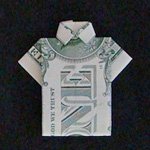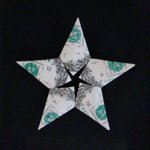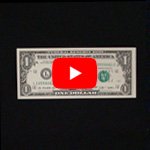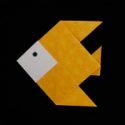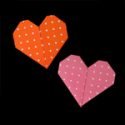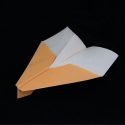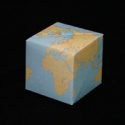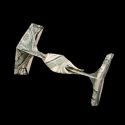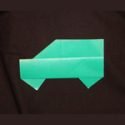Money Gift Box
by Clay Randall

This Money Gift Box is by Clay Randall and used to be found on this web site: http://members.cox.net/crandall11/money/box/
But this site is no longer active and we have captured the image and reproduce it here. Please contact us if you are the rightful owner of this diagram and wish for it to be removed. Otherwise, thank you for sharing your talent.
Gift Box
This box made from two bills. The bills/box can be the gift itself, but it is also just about the right size for a ring box. (Perhaps a dollar-bill ring?)
Get yourself two fairly new, crisp bills. Older "soggier" bills are much harder to work with. For this design to work, the folds should be very precise, and perpendicular to the edges of the bill if the resulting is to be rectangular.
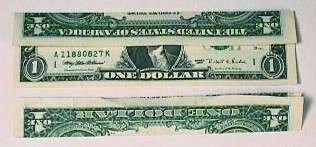
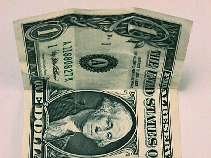

Fold the note top-to-bottom just to the right of the portrait, then unfold. Repeat just to the left of the portrait. I will refer to these as the portrait folds. Note that the third folds the oppose (are perpendicular to) the portrait folds.
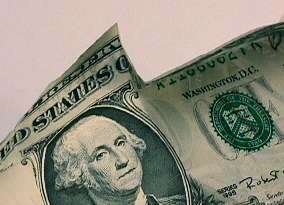

along the natural 45 degree line to complete the corner.
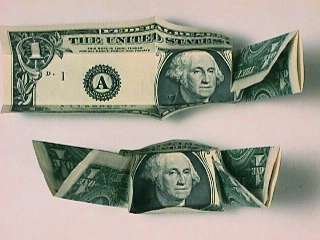
have two "tabs" sticking up on the left and right sides.
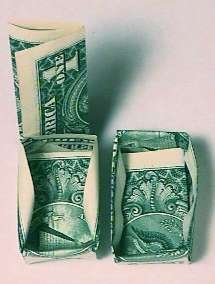
For each tab, pull it inside the box, folding so that the natural
edge of the box is pulled slightly over inside the fold.
(Look carefully at the bottom left of the picture.)
Do this evenly for both tabs.
For the two other sides, evenly fold over the edge of the bill.
You should now have an open box
If you make another piece just like the first, but slightly larger, you would have a lid similar to that found on most shoe boxes. To adjust the instructions above, you would fold so that the inner rectangle (bounded by the third and portrait folds) is slightly larger.
I do not like the way that looks, so I close the box another way as illustrated below. Try both – choose whichever you prefer.

Fold the second bill lengthwise so that the width matches the widest portion of the open box you just made. I will refer to this bill as the cover, and the previous piece made as the open box in the following steps.
You need two folds as shown to be able to follow the last step (see below). For general appearance, it is nice if these are nearly symmetrical as shown. These will be called the width folds.
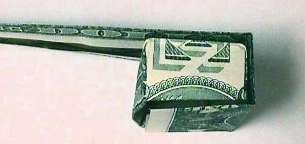
After folding, open the fold to 90 degrees, hold the cover back in place, and find the point for the next corner of the open box as the cover wraps around.

These will be called the wrapping folds.

I will call this the end cover fold.
In this illustration, the end cover fold is at the left edge of the picture. I have also (gently) completely unfolded the cover, refolded the end cover fold, the width folds, then the wrapping folds in that order. (This unfolding/refolding is optional, but makes the cover look nicer.)
In either case, the end cover fold puts the remainder of the long side inside the wrapping folds. Refold the wrapping folds holding the long side in place to crease it at the correct points.



- back to more dollar bill origami
- back to more origami instructions
- back to home page
- back to site map
- Like Us on Facebook
-
Books with Dollar Bill Origami
- The Buck Book by Anne A Johnson (book review)
- The Guide to Hawaiian Style Money Folds by Jodi Fukumoto (book review)
- The Guide to American Money Folds by Jodi Fukumoto (book review)
- Dollar Bill Origami by John Montroll (book review)
- Dollar Bill Animals in Origami by John Montroll
- Origami with Dollar Bills: Another Way to Impress People with Your Money! by Duy Nguyen
- Money Folding (Origami Favorites Series) by Florence Temko
Please Help
Please help by reporting broken links so that we can fix them. One easy message from you can save us hours and hours of clicking. Thanks!
-
More Origami Diagrams and Instructions…
-
These free origami instructions are made available to you by the paper folding community at large. If you have a diagram you would like to share, or if your diagram is listed here and you wish to have it removed, please Contact Us. Diagrams are intended for personal use. Copyright of the models lie with the origami creators and designers. Please contact the designer and/or creator directly for non-private usage of a model and/or artwork.

